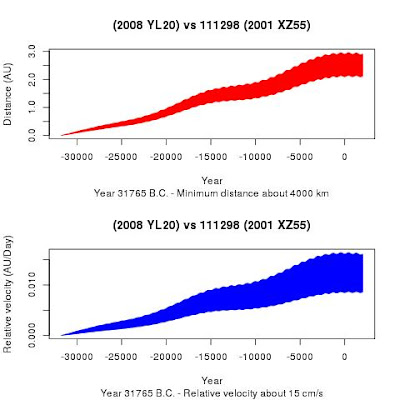See an update about this case received on Dec 10th: look at this MPML msg.
===============================================
I am looking again at these two asteroids.
===============================================
I am looking again at these two asteroids.
A couple of years ago, as clearly explained by Bill Gray (see MPML msg ), it was a bit too early to make meaningful simulations trying to go back in the past as far as about 25000 years ago.
Now the orbit uncertaintly of asteroid 2008 YL20 has improved from +/- 1.62e-6 degrees /day to +/-1.1568e-08 degrees/day.
I tried a new simulation to investigate the possibility that these two asteroids separated in the past and I got a new result consisting in a nominal
distance of about 4000 km, relative velocity about 15 cm/s. This event
occurred about 34000 years ago.
The uncertainty is 1.1568e-08 * 365 * 34000 = 0.14 degrees that at an average distance of 2.39 AU corresponds to an uncertainty of about 0.0057 AU (i.e. three time the moon-earth distance).
So ... on one side no proof that these asteroids separated but it seems to me that this pair is still interesting.
More details looking the JPL Small Body Data:
(111298) = 2001 XZ55
Orbital Elements at Epoch 2457200.5 (2015-Jun-27.0) TDB
Reference: JPL 11 (heliocentric ecliptic J2000)
| Element | Value | Uncertainty (1-sigma) | Units |
| e | .1837905901861221 | 6.7074e-08 | |
| a | 2.391320808768463 | 2.2177e-08 | AU |
| q | 1.951818546000553 | 1.6999e-07 | AU |
| i | 3.192061836722895 | 7.0356e-06 | deg |
| node | 111.491991193275 | 0.00011791 | deg |
| peri | 297.8338388091076 | 0.0001197 | deg |
| M | 257.5887075379197 | 2.2491e-05 | deg |
| tp | 2457584.738198736595 (2016-Jul-15.23819874) | 8.7199e-05 | JED |
| period | 1350.688466278188 3.70 | 1.879e-05 5.144e-08 | d yr |
| n | .2665307426456207 | 3.7078e-09 | deg/d |
| Q | 2.830823071536374 | 2.6253e-08 | AU |
2008 YL20
Orbital Elements at Epoch 2457200.5 (2015-Jun-27.0) TDB
Reference: JPL 8 (heliocentric ecliptic J2000)
| Element | Value | Uncertainty (1-sigma) | Units |
| e | .1837937583380851 | 5.5869e-07 | |
| a | 2.391150352530784 | 6.9177e-08 | AU |
| q | 1.951671842487714 | 1.3831e-06 | AU |
| i | 3.193600462494826 | 1.3927e-05 | deg |
| node | 111.4717983197325 | 0.00025271 | deg |
| peri | 298.0606134273407 | 0.00030036 | deg |
| M | 320.5524746963916 | 0.00012064 | deg |
| tp | 2457348.487835047940 (2015-Nov-21.98783505) | 0.00045708 | JED |
| period | 1350.544050792078 3.70 | 5.8608e-05 1.605e-07 | d yr |
| n | .2665592431352864 | 1.1568e-08 | deg/d |
| Q | 2.830628862573854 | 8.1891e-08 | AU |
Mercury Simulator Results
Simulation parameters:
algorithm (MVS, BS, BS2, RADAU, HYBRID etc) = bs2
start time (days)= 2457387.5
stop time (days) = -17.3d6
output interval (days) = 20
timestep (days) = 0.1
accuracy parameter=1.d-12
The result shown as a graph (done with R package):
Kind Regards,
Alessandro Odasso
Mercury Simulator - Mercury6
J.E.Chambers (1999) ``A Hybrid
Symplectic Integrator that Permits Close Encounters between
Massive Bodies''. Monthly Notices of the Royal Astronomical
Society, vol 304, pp793-799.

No comments:
Post a Comment
Note: Only a member of this blog may post a comment.